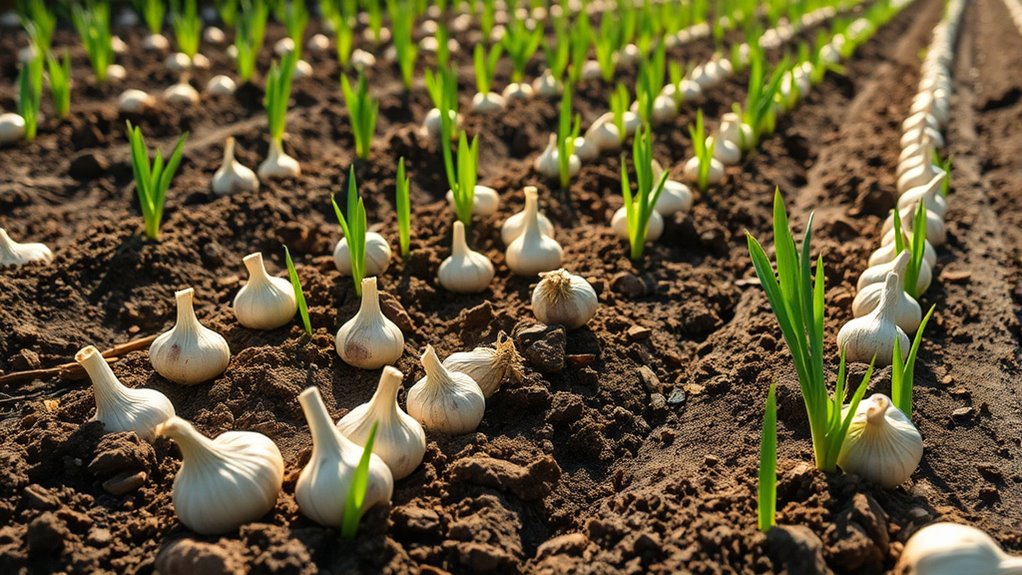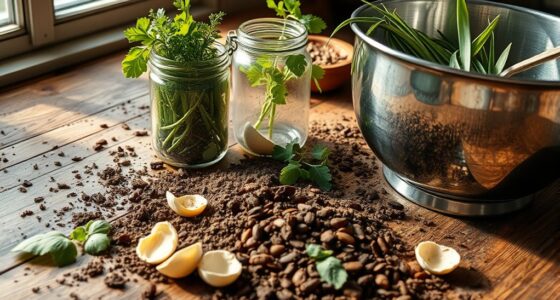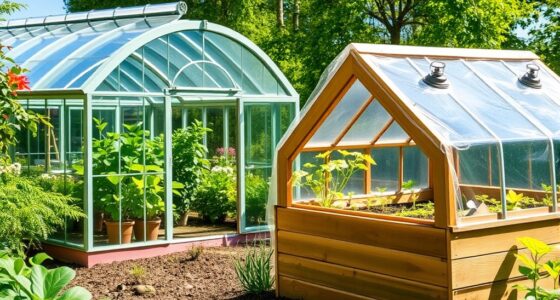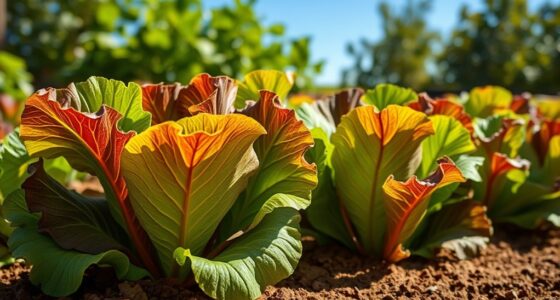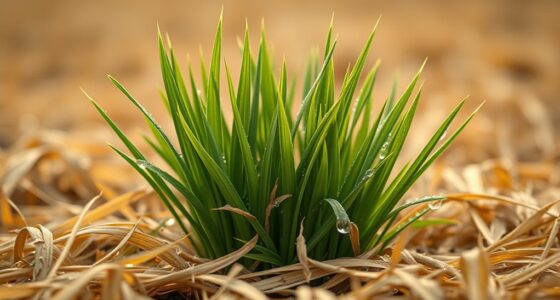To plant garlic and onions for a spring harvest, choose the right varieties based on your climate and culinary preferences. Plant just before the last frost, with garlic cloves about 2 inches deep and onions set slightly shallower. Prepare your soil by loosening it, removing weeds, and enriching it with compost. Proper spacing, watering, and pest control are essential. For detailed steps on timing, techniques, and care, keep exploring these key tips to guarantee a successful harvest.
Key Takeaways
- Plant garlic 4-6 weeks before the last frost, ensuring soil temperatures are between 50-70°F for optimal growth.
- Prepare well-drained, nutrient-rich soil with compost; plant garlic cloves 2 inches deep and onion sets 1-1.5 inches deep.
- Space garlic 4-6 inches apart and onions 4-5 inches apart, arranging rows north-south for even sunlight exposure.
- Use organic pest control methods like companion planting and neem oil to protect young plants from pests and diseases.
- Harvest when tops yellow and fall over, then cure in a dry, ventilated space before storing in a cool, dark, airy location.
Choosing the Right Garlic and Onion Varieties
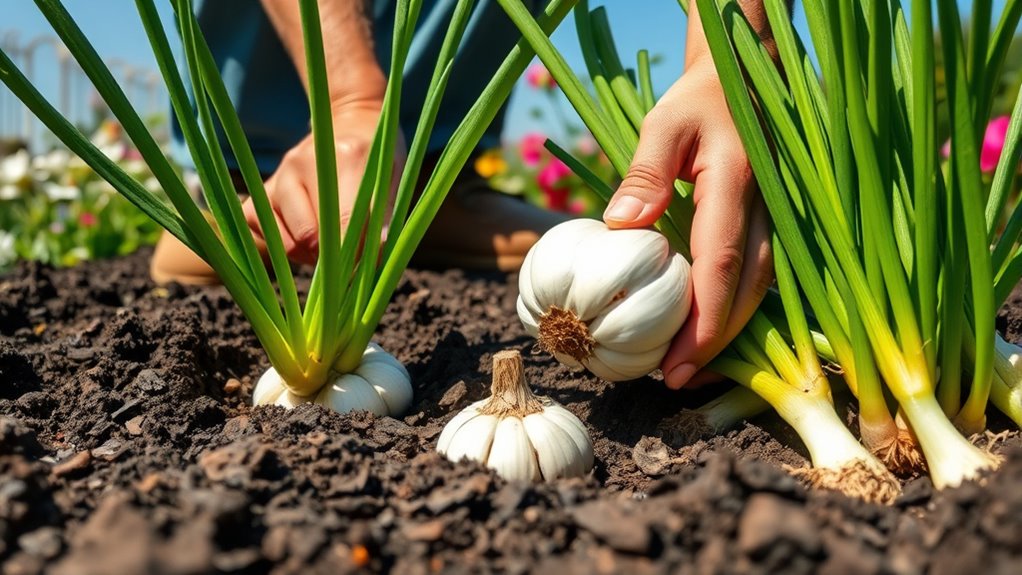
When selecting garlic and onion varieties, it’s important to take into account your local climate, soil conditions, and your specific growing goals. For example, if you live in a cooler region, choose hardneck garlic, which withstands colder temperatures and offers robust flavor. In warmer areas, softneck garlic tends to perform better and stores longer. Onions also vary: short-day varieties are suited for southern regions with milder winters, while long-day types thrive in northern climates with longer daylight hours. Consider your culinary preferences too—whether you want milder, sweet, or more pungent flavors. Selecting the right varieties ensures healthy growth, better yields, and a more satisfying harvest. Tailoring your choices to your environment maximizes your success from the very start. Additionally, understanding the different garlic and onion varieties can help you make more informed decisions that align with your gardening conditions.
Timing Your Planting for Optimal Growth
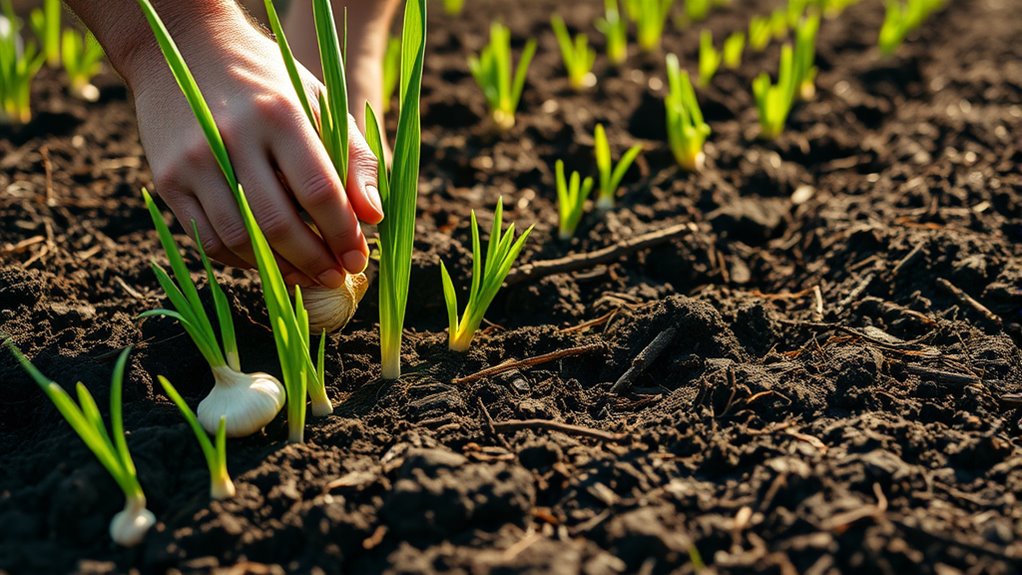
Timing your planting correctly is essential to ensuring your garlic and onions develop strong, healthy bulbs. When you plant at the right time, you give your crops the best chance to thrive and produce a bountiful harvest. To do this effectively, consider these key points:
- Know your local climate and frost dates to plant just before the last expected frost.
- For spring harvests, plant garlic and onions 4-6 weeks before your area’s last frost date.
- Use soil temperature as a guide; ideal temperatures are between 50-70°F (10-21°C) for planting.
- Avoid planting too early or late, as this can lead to poor bulb development or disease susceptibility.
Sticking to these timing tips will help you maximize your crop’s growth potential.
Preparing the Soil for Spring Planting
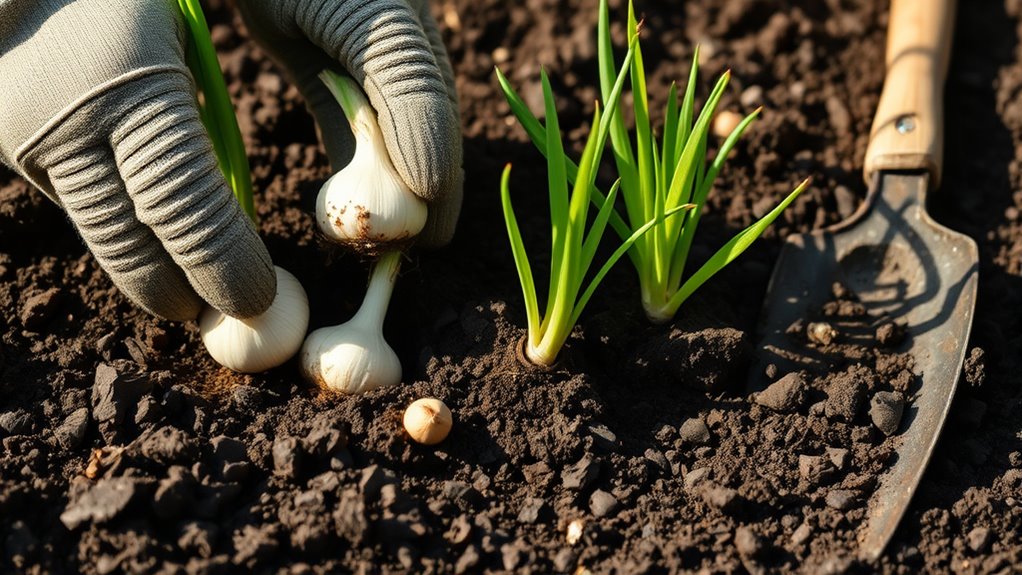
To guarantee your garlic and onions grow strong and healthy, start by preparing the soil thoroughly before planting. First, clear out weeds and debris to prevent competition for nutrients. Next, loosen the soil to improve aeration and drainage, which encourages healthy root growth. Enrich your soil with compost or well-rotted manure to supply essential nutrients. Test the pH; garlic and onions prefer slightly acidic to neutral soil, around 6.0 to 7.0. Incorporate the amendments evenly to ensure consistent growth. Proper soil prep sets the foundation for a healthy spring harvest and aligns with soil health principles that promote sustainable gardening practices.
Planting Techniques for Garlic and Onions
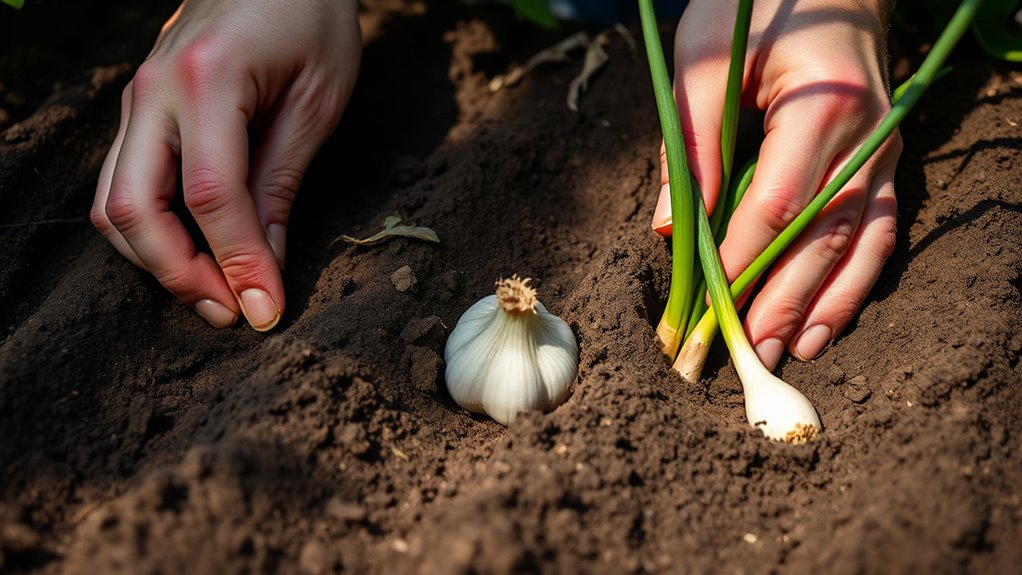
To grow healthy garlic and onions, you need to master proper planting techniques. Focus on preparing the soil well, planting at the right depths, and arranging your bulbs with appropriate spacing. These steps will guarantee your crops develop strong roots and plenty of bulbs. Additionally, selecting moisture-resistant materials and implementing eco-friendly practices can contribute to healthier plants and a more sustainable harvest.
Soil Preparation Tips
Preparing the soil properly is essential for healthy garlic and onion growth. Good soil sets the foundation for strong bulbs and vibrant plants. First, test your soil’s pH; garlic and onions thrive in slightly acidic to neutral soil, around 6.0 to 7.0. Second, enrich the soil with compost or organic matter to improve drainage and fertility. Third, loosen the soil to a depth of at least 8 inches, breaking up clumps and aerating roots. Fourth, remove weeds and debris that could compete for nutrients. These steps guarantee your soil offers ideal conditions for planting. Proper preparation promotes healthy root development and higher yields. Taking time to prepare your soil can make a significant difference in the success of your garlic and onion crops. Additionally, understanding soil health can help you maintain long-term productivity and resilience of your garden.
Proper Planting Depths
Proper planting depths are essential for ensuring garlic and onions develop strong roots and healthy bulbs. For garlic, plant each clove about 2 inches deep, with the pointed end facing up. This depth allows the clove to establish roots while protecting it from temperature fluctuations. Onions should be planted approximately 1 to 1.5 inches deep, depending on the size of the seed or set. Larger onion sets require a slightly deeper planting to support bulb formation. When planting, make sure the tops are just covered with soil to prevent drying out and to encourage steady growth. Proper depth helps prevent weeds, reduces the risk of rot, and guarantees the bulbs have enough space to develop fully. Consistently maintaining correct depths promotes a healthy, bountiful harvest, especially when considering the importance of remote work in managing time efficiently to tend to your garden.
Spacing and Arrangement
Spacing and arrangement play a vital role in guaranteeing garlic and onions grow healthy and develop well-formed bulbs. Proper spacing prevents overcrowding, reduces disease risk, and allows airflow. Here are key tips to optimize your planting:
- Space garlic cloves about 4-6 inches apart in rows 12 inches apart.
- Plant onion sets 1-2 inches deep, with 4-5 inches between each set.
- Arrange rows to run north-south for even sunlight exposure.
- Keep spacing consistent to assure uniform bulb development and easier maintenance.
- Ensuring proper plant spacing is essential for preventing disease and promoting healthy growth.
Watering and Mulching Practices
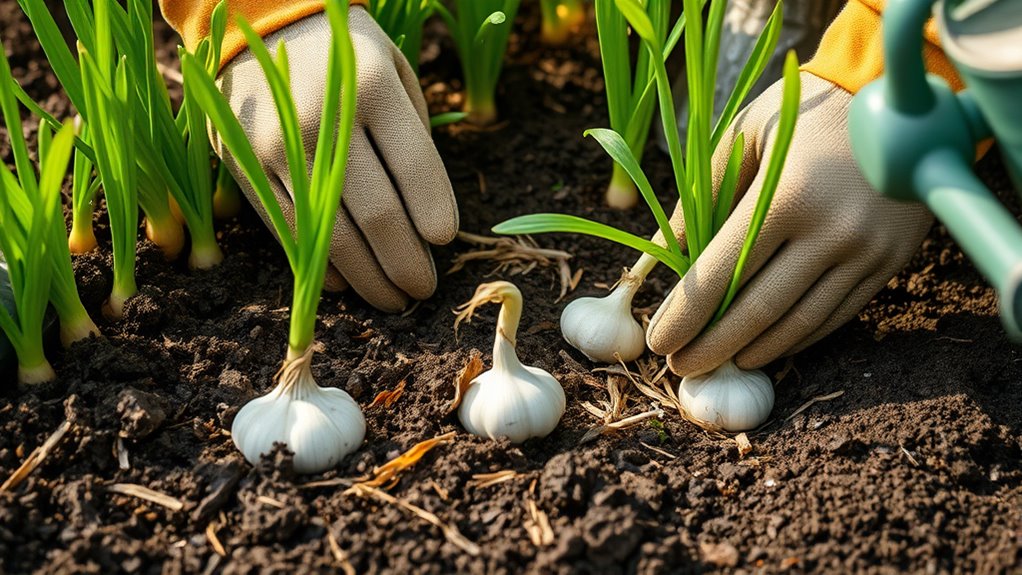
Consistent watering is essential for healthy garlic and onion growth, especially during the early stages. Aim to keep the soil evenly moist, not waterlogged, to promote strong root development. Mulching helps retain soil moisture, suppress weeds, and regulate temperature. Apply a layer of organic mulch, like straw or shredded leaves, around your plants, ensuring it doesn’t touch the bulbs directly. Proper watering and mulching can also improve your divorce experience by reducing stress and uncertainty during transitional periods.
Here’s how watering and mulching impact your garden:
| Effect on Plants | Emotional Benefit | Practical Tip |
|---|---|---|
| Prevents drought stress | Peace of mind knowing plants are secure | Water deeply once a week |
| Maintains consistent moisture | Confidence in steady growth | Use mulch to conserve water |
| Protects against weeds | Less worry about pests | Replenish mulch monthly |
| Regulates soil temperature | Comfort for your plants | Keep mulch 2-3 inches deep |
| Promotes healthy bulbs | Satisfaction of harvest | Adjust watering based on weather |
Managing Pests and Diseases
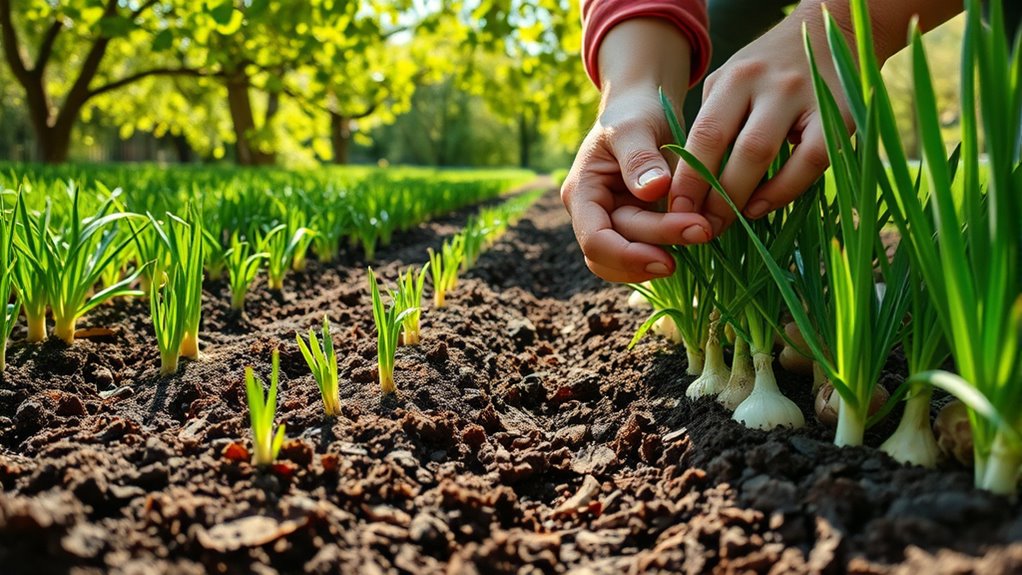
To keep your garlic and onions healthy, start with preventative measures like crop rotation and proper spacing to reduce pest and disease risks. Learn to spot signs of trouble early using simple identification techniques, so you can act quickly. Consider organic methods, such as neem oil or insecticidal soap, to manage pests without harming your plants. Additionally, practicing mindful decluttering strategies in your gardening space can help you maintain an organized environment that minimizes clutter and promotes plant health.
Preventative Measures for Pests
Preventative measures are essential for keeping pests and diseases at bay in your garlic and onion crops. By acting early, you reduce the risk of infestations and protect your harvest. Here are four effective strategies:
- Rotate crops annually to prevent pest buildup in the soil.
- Use pest-resistant onion and garlic varieties when possible.
- Maintain proper spacing to improve air circulation and reduce humidity that pests favor.
- Keep your garden free of weeds, which can harbor pests and diseases.
- Regularly inspecting your plants helps catch issues early and monitoring vacuum performance ensures your equipment functions optimally.
These steps create an inhospitable environment for pests, minimizing the need for chemical treatments. Staying proactive ensures a healthy, pest-free crop come harvest time.
Disease Identification Techniques
Effective disease identification is crucial for managing pests and maintaining healthy garlic and onion crops. To spot issues early, regularly inspect your plants for unusual spots, discoloration, or wilting. Look closely at leaves, stems, and bulbs for signs of mold, rot, or lesions. Keep an eye out for powdery or fuzzy growths that could indicate fungal infections. Note any yellowing or browning, which might signal disease progression. Use a magnifying glass to examine suspicious areas closely. Take pictures to track symptoms over time. If you notice symptoms, compare them with trusted gardening resources or consult local extension services for accurate diagnosis. Early detection allows you to take targeted action, preventing disease spread and protecting your harvest.
Organic Pest Control Methods
Organic pest control methods offer safe and sustainable ways to protect your garlic and onion crops from pests and diseases. You can proactively manage issues by using natural solutions that won’t harm beneficial insects or the environment. Here are four effective methods:
- Companion planting – Grow herbs like basil or marigolds nearby to repel pests.
- Neem oil – Apply neem oil as a natural pesticide that targets a variety of pests.
- Handpicking – Regularly inspect plants and remove pests by hand before they spread.
- Crop rotation – Change planting locations each season to prevent pest buildup and reduce disease risk.
Implementing these strategies helps keep your garden healthy, pest-free, and productive throughout the season.
Fertilizing for Healthy Bulb Development
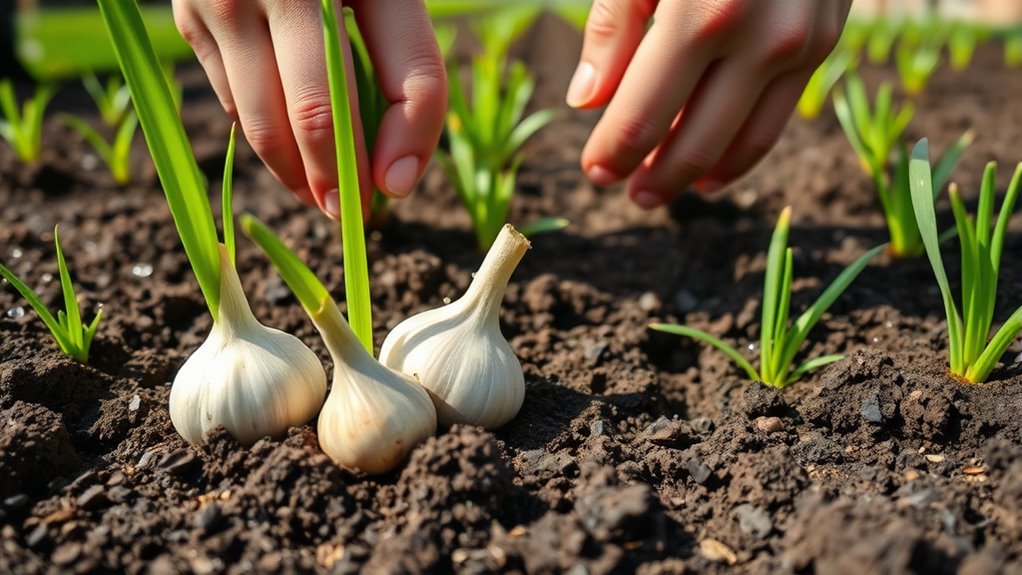
To guarantee your garlic and onions develop strong, healthy bulbs, proper fertilization is essential. You should start by applying a balanced fertilizer rich in phosphorus and potassium before planting, which encourages root and bulb growth. During the growing season, side-dress your crops with a high-nitrogen fertilizer every few weeks to support foliage development. Be careful not to over-fertilize, as too much nitrogen can lead to lush tops but smaller bulbs. Incorporate organic matter like compost or aged manure into the soil to improve nutrient retention and soil health. Keep the soil consistently moist but not waterlogged, as uneven watering can hinder nutrient uptake. Proper fertilization ensures your bulbs grow larger, healthier, and more flavorful come harvest time. Additionally, selecting the right fertilizer type can optimize nutrient absorption and promote robust bulb development.
Harvesting and Storage Tips
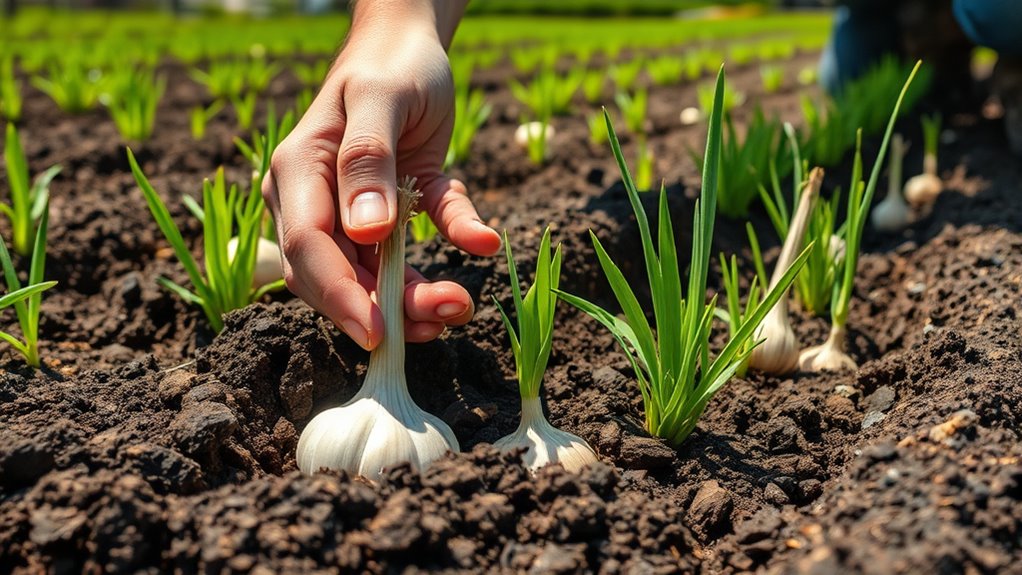
Timing is essential when harvesting garlic and onions; wait until the tops begin to yellow and fall over naturally before pulling them from the ground. This signals that the bulbs have matured. Once ready, gently loosen the soil around the bulbs to prevent damage. After harvesting, cure your garlic and onions in a warm, dry, well-ventilated area for about 2-3 weeks until the skins are papery. Proper storage extends their shelf life. Here are some tips to help you store your harvest effectively:
Harvest garlic and onions when tops yellow and fall over naturally for best results.
- Keep bulbs in a cool, dark place with good air circulation.
- Avoid storing in plastic bags to prevent moisture buildup.
- Trim roots and tops before storage, but don’t cut too close.
- Regularly check for signs of spoilage and remove affected bulbs.
Frequently Asked Questions
How Can I Tell if Garlic or Onions Are Ready to Harvest?
You can tell garlic and onions are ready to harvest when their tops start to yellow and fall over. For garlic, wait until the lower leaves turn brown while the upper ones stay green. Onions are ready when the tops fall over and begin to dry out. Gently lift a bulb to check its size, ensuring it’s mature enough before pulling the entire plant.
What Are Common Signs of Pests Affecting Garlic and Onions?
You’ll notice pests, surprisingly, by their uninvited signs—chewed leaves, tiny holes, or sticky residue. Aphids cluster on new growth, while thrips cause silvery streaks. Watch out for onion maggots tunneling into bulbs or garlic mites causing discoloration. Ironically, pests often reveal themselves just as your plants look the healthiest. Regular inspections, especially under leaves and around the base, help you catch these troublemakers early before they cause real damage.
Can I Plant Garlic and Onions in Containers Instead of the Ground?
Yes, you can plant garlic and onions in containers instead of the ground. Use well-draining soil and choose containers with drainage holes to prevent waterlogging. Make sure the containers are deep enough—at least 8-12 inches—for the bulbs to develop properly. Place them in a sunny spot and water regularly. Container planting makes it easier to control pests and soil quality, giving your garlic and onions a healthy start.
How Do I Prevent Bolting in Garlic and Onions During Spring?
To prevent bolting in garlic and onions during spring, you should keep the soil consistently moist and avoid sudden temperature fluctuations. Plant them at the appropriate time, usually when soil temperatures are cool, and make certain they get plenty of sunlight without overheating. Mulch around your plants to maintain even soil temperature and promote steady growth. Regularly monitor weather patterns and adjust watering to prevent stress that can trigger bolting.
Are There Organic Methods to Control Diseases in Garlic and Onion Crops?
You can control diseases in garlic and onion crops organically by practicing crop rotation to prevent soil-borne illnesses, using disease-resistant varieties, and ensuring proper spacing for airflow. Apply organic fungicides like neem oil or copper sprays, and remove infected plants promptly. Maintain healthy soil with compost and avoid overhead watering to reduce moisture-related diseases. Regularly inspecting your crops helps catch issues early, keeping your plants healthier naturally.
Conclusion
By choosing the right varieties, timing your planting, and giving your garlic and onions the care they need, you’ll set yourself up for a bountiful spring harvest. Think of your garden as a symphony—each step, from soil prep to harvesting, plays a essential role. With patience and attention, you’ll watch your bulbs flourish, turning your garden into a treasure trove of flavors. Get ready to enjoy the fruits of your labor and savor the taste of success.

